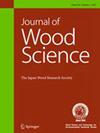粒径和混合比对茶油-油茶壳刨花板孔隙率和性能的影响
IF 2.4
3区 农林科学
Q2 FORESTRY
引用次数: 5
摘要
本文研究了颗粒大小和混合比例对刨花板孔隙率的相互作用及其对刨花板物理力学性能的影响。茶油山茶花壳(TOCS)每年可提供180万吨木质纤维素原料,是生产刨花板的有用资源。为此,研究了不同粒径(粗粒和细粒)和混合比例(木材和TOCS)的刨花板与聚亚甲基聚苯基聚异氰酸酯(pMDI)的粘合。结果表明,用TOCS颗粒制成的刨花板密度高于商用木材颗粒。此外,细颗粒制成的刨花板具有较低的孔隙率。物理力学性能的平均值表明,除厚度膨胀(TS)外,粗颗粒的大多数性能都较好。在所有性能方面,结果表明,添加50%的商业木材与TOCS颗粒,无论颗粒大小,都可以提供可接受的结果,符合EN 312:2010标准对p2型刨花板(干燥条件下使用的室内装修(包括家具)板)的所有要求。此外,由于外壳的多孔结构,tocs基刨花板与木质刨花板相比具有更好的导热性。本文章由计算机程序翻译,如有差异,请以英文原文为准。
Interaction between particle size and mixing ratio on porosity and properties of tea oil camellia (Camellia oleifera Abel.) shells-based particleboard
This study investigated the interaction between particle size and mixing ratio on the porosity of particleboard and in consequence its effect on the physical and mechanical properties of panels. Tea Oil Camellia Shell (TOCS), which could provide 1.8 million tons of lignocellulose raw material annually, can be a useful resource for particleboard production. In that regard, particleboards with different particle sizes (coarse and fine) and mixing ratios (wood and TOCS) bonded with Polymethylene polyphenyl polyisocyanate (pMDI) were investigated. The results showed that particleboard made with TOCS particles had higher densities than those of commercial wood particles. Furthermore, particleboards made with fine particles had lower porosity. The average values for physical and mechanical properties have shown that except for thickness swelling (TS), most properties were better with coarse particles. In terms of all properties, results showed that adding 50% of commercial wood in conjunction with TOCS particles regardless of particle size can offer acceptable results, which qualified all requirements of EN 312:2010 standard for P2-type particleboard (boards for interior fitments (including furniture) for use in dry conditions). In addition, due to the porous structure of the shells, TOCS-based particleboards have better thermal conductivity compared to wood-based particleboards.
求助全文
通过发布文献求助,成功后即可免费获取论文全文。
去求助
来源期刊

Journal of Wood Science
工程技术-材料科学:纸与木材
CiteScore
5.40
自引率
10.30%
发文量
57
审稿时长
6 months
期刊介绍:
The Journal of Wood Science is the official journal of the Japan Wood Research Society. This journal provides an international forum for the exchange of knowledge and the discussion of current issues in wood and its utilization. The journal publishes original articles on basic and applied research dealing with the science, technology, and engineering of wood, wood components, wood and wood-based products, and wood constructions. Articles concerned with pulp and paper, fiber resources from non-woody plants, wood-inhabiting insects and fungi, wood biomass, and environmental and ecological issues in forest products are also included. In addition to original articles, the journal publishes review articles on selected topics concerning wood science and related fields. The editors welcome the submission of manuscripts from any country.
 求助内容:
求助内容: 应助结果提醒方式:
应助结果提醒方式:


